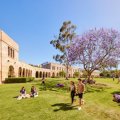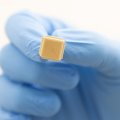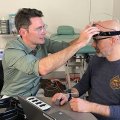The University of Queensland will receive $29.79 million for 92 grants in the 2012 round one funding of the Australian Research Council Discovery Projects scheme announced today.
UQ topped the nation in the number of grants awarded, and was second nationally in the dollar value of supported projects, earning more than one tenth of the total amount of $236.8 million awarded nationally.
Deputy Vice-Chancellor (Research) Professor Max Lu congratulated UQ researchers on their success in the scheme, which he said reflected well on UQ’s reputation as a top tier research institution.
“We are delighted at the outstanding results and I thank the Minister and the Australian Research Council for supporting important basic and applied research projects that will benefit society,” he said.
“The results indicate the quality of our researchers and their dedication to expanding the boundaries of human knowledge.
“UQ achieved an excellent success rate — 29.68 per cent — so almost one in three of our applications were successful.
“This is a tribute to the internal processes and value-adding achieved by our Research and Innovation team.”
Supported projects include research into an image guidance system for improved cancer treatment and patient outcomes; parenting interventions; the value provided by corporate boards; the development of modern historical writing; wastewater systems; accidents which occur when people are lost in thought; reducing the burden of tobacco-related harm; sleep apnea and snoring, which affects about 800,000 Australians; scramjets; new types of solar cells; and justice for victims of sexual assault.
The largest individual UQ Discovery Project grant was awarded to Professor Justin Marshall, of UQ’s Queensland Brain Institute, who receives $962,000, including a Discovery Outstanding Researcher Award (DORA), for a three-year study of colour and polarisation vision on the Great Barrier Reef.
As the tightest-packed ecosystem on the planet, coral reefs make for a competitive environment, from which has evolved unique sensory adaptations that Professor Marshall’s research will investigate.
“Australian neuroscience has much to learn by examining brains and visual systems working in their own natural habitats,” Professor Marshall says.
“Many reef animals visualise and communicate with light that humans cannot see, or interpret the light we can see in more detail.
“My aim is to translate these previously unexplored languages.”
Many of the animals Professor Marshall studies, including cephalopods (octopus, squid and cuttlefish) and stomatopods (mantis shrimps), possess colour vision that outperforms humans, while some also have polarisation vision which humans lack altogether.
“For example, while we possess three channels called cone cells for colour vision in our eyes, stomatopods have twelve,” he explains.
“A range of techniques and methods developed in my laboratory, such as underwater spectrophotometry, photography, unique behavioural tests and mathematical modeling of animal vision, will be used to understand the design of visual signals and systems in the light of ecology, behaviour and evolution.”
Professor Marshall’s grant includes a Discovery Outstanding Researcher Award, of which only 26 were awarded Australia-wide.
Professor Philip Hugenholtz, of UQ’s School of Chemistry and Molecular Biosciences, was awarded $870,000 including a DORA for a study towards providing a complete view of life on earth via single cell genomics.
Genome sequencing has revolutionised biology, but for most microorganisms this revolution has not arrived because the majority cannot be grown in the laboratory.
This project will address this challenge by targeted sequencing of single cells from the environment.
Other significant ARC Discovery Project grants to UQ researchers included:
• $700,000 to Professor Paul Burn and Professor Ian Gentle of UQ’s School of Chemistry and Molecular Biosciences and Professor Michael James of ANSTO (Australian Nuclear Science and Technology Organisation) to look at diffusion, a key to performance in optoelectronic devices. In the future, new types of displays, solar cells and sensors for explosives based on organic materials will be common. This project will look at the movement of molecules between layers making up these devices.
• $427,695 to Dr Rebecca Wickes of the School of Social Science and colleagues for the first study to examine the key community processes and structures associated with community resilience both before and after the 2011 Brisbane floods. Drawing on a longitudinal study of Brisbane suburbs, it will critically assess the conditions under which suburban communities respond to, and recover from a major disaster.
• $510,000 to Professor Peter Koopman of UQ’s Institute for Molecular Bioscience, to reveal how the Y chromosome directs male development, identify steps that can go wrong, and suggest ways to diagnose and manage intersex conditions. It will also inform stem cell, pest management, wildlife conservation and livestock breeding technologies.
• $390,000 to Professor Anton Middelberg from the Australian Institute for Bioengineering and Nanotechnology to research new detergents that are both sustainable and stimuli-responsive, meaning that foam can be switched on and off as needed.
• $540,000 to a project led by Professor Richard Morgan (UQ School of Mechanical and Mining Engineering), Professor Tim McIntyre (UQ School of Mathematics and Physics) and colleagues at other institutions to study re-entry heat shields by experiments simulating hypervelocity atmospheric flight. The results will enable the design of advanced spacecraft needed to extend exploration of the universe.
• $540,000 to Professor Zhiguo Yuan of the Advanced Water Management Centre and Dr Florent Angly of the School of Chemistry and Molecular Biosciences to support sustainable environment management by investigating a previously unrecognised microbial process that oxidises methane before it reaches the atmosphere.
• $600,000, including a DORA, to Professor Darryn Bryant of UQ’s School of Mathematics and Physics for a study to answer two long-standing and fundamental questions in graph theory, used extensively to model and solve practical problems in physical, biological and social systems.
• $170,000 to Associate Professor Alicia Rambaldi of the School of Economics and colleagues for conduct econometric modeling of housing prices and their relationship to climate adaptation issues. The project aims to develop improved and new methods for predicting property prices and their components, land and structure, and it will provide estimates of the interplay between flooding risk and property values.
More details: arc.gov.au
Media: Jan King 0413 601 248.
.jpg)











